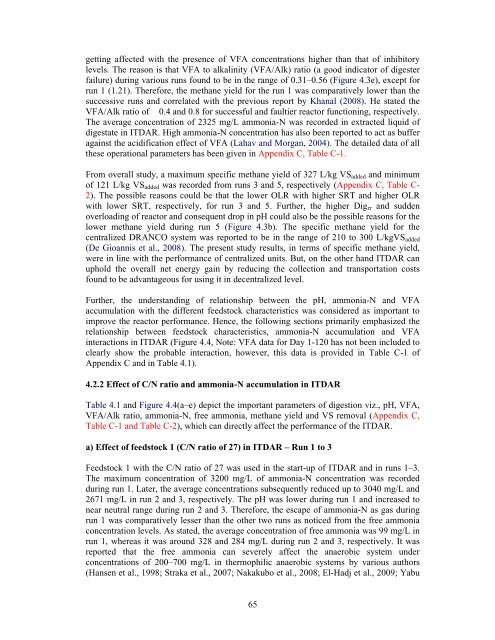dry anaerobic digestion of municipal solid waste and digestate ...
dry anaerobic digestion of municipal solid waste and digestate ...
dry anaerobic digestion of municipal solid waste and digestate ...
You also want an ePaper? Increase the reach of your titles
YUMPU automatically turns print PDFs into web optimized ePapers that Google loves.
getting affected with the presence <strong>of</strong> VFA concentrations higher than that <strong>of</strong> inhibitory<br />
levels. The reason is that VFA to alkalinity (VFA/Alk) ratio (a good indicator <strong>of</strong> digester<br />
failure) during various runs found to be in the range <strong>of</strong> 0.31–0.56 (Figure 4.3e), except for<br />
run 1 (1.21). Therefore, the methane yield for the run 1 was comparatively lower than the<br />
successive runs <strong>and</strong> correlated with the previous report by Khanal (2008) . He stated the<br />
VFA/Alk ratio <strong>of</strong> ≤ 0.4 <strong>and</strong> 0.8 for successful <strong>and</strong> faultier reactor functioning, respectively.<br />
The average concentration <strong>of</strong> 2325 mg/L ammonia-N was recorded in extracted liquid <strong>of</strong><br />
<strong>digestate</strong> in ITDAR. High ammonia-N concentration has also been reported to act as buffer<br />
against the acidification effect <strong>of</strong> VFA (Lahav <strong>and</strong> Morgan, 2004). The detailed data <strong>of</strong> all<br />
these operational parameters has been given in Appendix C, Table C-1.<br />
From overall study, a maximum specific methane yield <strong>of</strong> 327 L/kg VSadded <strong>and</strong> minimum<br />
<strong>of</strong> 121 L/kg VSadded was recorded from runs 3 <strong>and</strong> 5, respectively (Appendix C, Table C-<br />
2). The possible reasons could be that the lower OLR with higher SRT <strong>and</strong> higher OLR<br />
with lower SRT, respectively, for run 3 <strong>and</strong> 5. Further, the higher Digrr <strong>and</strong> sudden<br />
overloading <strong>of</strong> reactor <strong>and</strong> consequent drop in pH could also be the possible reasons for the<br />
lower methane yield during run 5 ( Figure 4.3b). The specific methane yield for the<br />
centralized DRANCO system was reported to be in the range <strong>of</strong> 210 to 300 L/kgVSadded<br />
(De Gioannis et al., 2008). The present study results, in terms <strong>of</strong> specific methane yield,<br />
were in line with the performance <strong>of</strong> centralized units. But, on the other h<strong>and</strong> ITDAR can<br />
uphold the overall net energy gain by reducing the collection <strong>and</strong> transportation costs<br />
found to be advantageous for using it in decentralized level.<br />
Further, the underst<strong>and</strong>ing <strong>of</strong> relationship between the pH, ammonia-N <strong>and</strong> VFA<br />
accumulation with the different feedstock characteristics was considered as important to<br />
improve the reactor performance. Hence, the following sections primarily emphasized the<br />
relationship between feedstock characteristics, ammonia-N accumulation <strong>and</strong> VFA<br />
interactions in ITDAR (Figure 4.4, Note: VFA data for Day 1-120 has not been included to<br />
clearly show the probable interaction, however, this data is provided in Table C-1 <strong>of</strong><br />
Appendix C <strong>and</strong> in Table 4.1).<br />
4.2.2 Effect <strong>of</strong> C/N ratio <strong>and</strong> ammonia-N accumulation in ITDAR<br />
Table 4.1 <strong>and</strong> Figure 4.4(a–e) depict the important parameters <strong>of</strong> <strong>digestion</strong> viz., pH, VFA,<br />
VFA/Alk ratio, ammonia-N, free ammonia, methane yield <strong>and</strong> VS removal (Appendix C,<br />
Table C-1 <strong>and</strong> Table C-2), which can directly affect the performance <strong>of</strong> the ITDAR.<br />
a) Effect <strong>of</strong> feedstock 1 (C/N ratio <strong>of</strong> 27) in ITDAR – Run 1 to 3<br />
Feedstock 1 with the C/N ratio <strong>of</strong> 27 was used in the start-up <strong>of</strong> ITDAR <strong>and</strong> in runs 1–3.<br />
The maximum concentration <strong>of</strong> 3200 mg/L <strong>of</strong> ammonia-N concentration was recorded<br />
during run 1. Later, the average concentrations subsequently reduced up to 3040 mg/L <strong>and</strong><br />
2671 mg/L in run 2 <strong>and</strong> 3, respectively. The pH was lower during run 1 <strong>and</strong> increased to<br />
near neutral range during run 2 <strong>and</strong> 3. Therefore, the escape <strong>of</strong> ammonia-N as gas during<br />
run 1 was comparatively lesser than the other two runs as noticed from the free ammonia<br />
concentration levels. As stated, the average concentration <strong>of</strong> free ammonia was 99 mg/L in<br />
run 1, whereas it was around 328 <strong>and</strong> 284 mg/L during run 2 <strong>and</strong> 3, respectively. It was<br />
reported that the free ammonia can severely affect the <strong>anaerobic</strong> system under<br />
concentrations <strong>of</strong> 200–700 mg/L in thermophilic <strong>anaerobic</strong> systems by various authors<br />
(Hansen et al., 1998; Straka et al., 2007; Nakakubo et al., 2008; El-Hadj et al., 2009; Yabu<br />
65

















